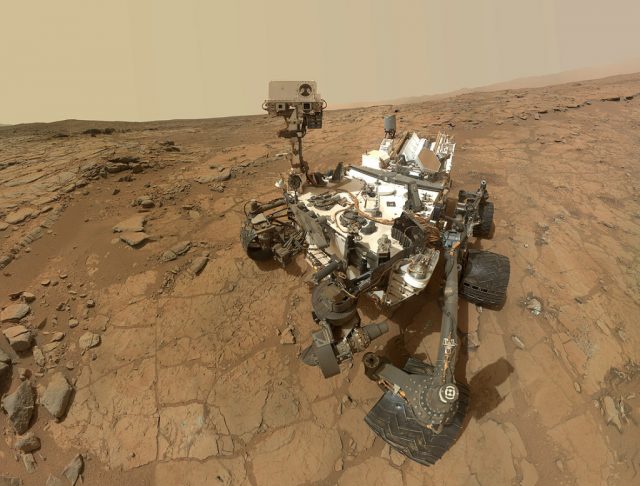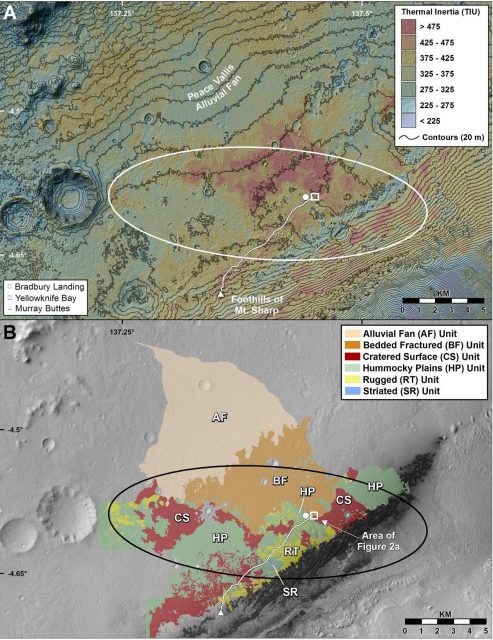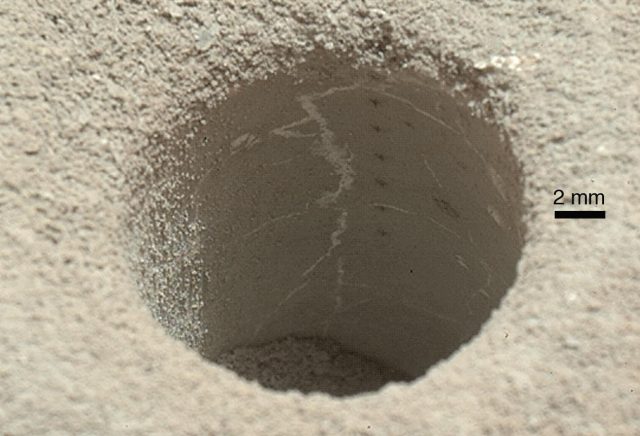Curiosity and the quest for a habitable environment on Mars

Curiosity has been studying the surface of Mars since its landing on August 6, 2012, at Gale Crater. One of its primary goals was to determine Mar’s habitability, present or past, as written in the geology of the red planet. For doing so, and after not a little debate, the landing site was selected to be a crater 3,5 to 3,8 billion years old, close to the Martian dichotomy. This is the separation between the southern highlands and the northern lowlands, sometimes thought to be reminiscent of an ancient sea in the boreal latitudes. The crater displays a number of geologically different terrains too, making it possible to study a good number of scenarios in a limited region of the planet. The ultimate destination of the rover, Aeolius Mons (also known as. Mount Sharp) is expected to exhibit a number of strata along its hills, thus making possible a time travel in a single location.

Grotzinger and collaborators 1 have recently argued that the recent results thrown by Curiosity rover support the idea of a Martian biosphere potentially habitable by chemolithoautotrophs. Such organisms, on Earth, get energy for their metabolism by oxidizing inorganic compounds and their carbon from carbon dioxide fixing. Grotzinger et al. show the existence of a fluvial-lacustrine environment in the Yellowknife Bay region of Crater Gale during periods longer than hundred to tens of thousand of years. The upper limit for the existence of this relatively friendly environment could have been some millions of years. The terrain is too relatively young in terms of the Mars geological history which is somewhat surprising with respect to the usually accepted evolution of aequous environments on the red planet.
However, in order to have this kind of habitable environment an additional number of circumstances need to be proven. The mineralogy of some sedimentary rocks at the location of interest has been presented by Vaniman and collaborators 2 in a companion paper. A couple of interesting samples have been analyzed by Curiosity’s facilities retrieving their detailed composition. Two results can be highlighted from Vaniman’s work. First of all, the absence of iron sulfates in the samples, with calcium sulfates instead, points to an environment with almost neutral or moderate pH. Secondly, mineralogy supports the dating of these rocks maybe as young as Early Hesperian, a period when Mars changed from a possibly humid past to a dry and cold present.
This point of view is complemented by the geochemistry provided by Mars Science Laboratory 3. The magnetites and phyllosilicates show no geochemical variations, thus pointing again to diagenetic rock formation in a cold and aequous ambient with neutral acidity. It also proves that the salinity in the ancient lake was low, again providing a more friendly habitat for the potential inhabitants.

While Opportunity rover, still working on Mars’ surface ten years after, is unable to directly detect Carbon or Nitrogen, two key components for life, Curiosity is well capable of doing so. It detected many volatiles and organics while drilling the targets described above, as described by Ming et al. 4. Such compounds included H2O, CO2, NO, chlorinated hydrocarbons and many others. In fact, the higher abundance of the latter when compared with more modern materials suggest that carbon is Martian in origin, or that it came from organic meteoritic sources and it was preserved in the mudstones analyzed here. However, the first results coming from the Mars Science Laboratory rover raised the question of whether or not there was a substantial terrestrial contamination in the very first carbon detections. Right now, Sample Analysis at Mars (SAM) team quantifies contamination in less than 3% of the total carbon detection, thus giving a reliable detection of carbon in the samples.
All in all, what we have here is an ancient, though less than expected, terrain with retains the traces of a fluvial or lacustrine environment in a cold, arid climate. This has been compared to high altitude desserts like the one in Atacama, Chile. The chemistry involved here not only points to having all the ingredients required for life, not life itself, but also tells us how this clues can be preserved under the martian conditions. This is very important not for Curiosity but for subsequent mission which might be able to look for life and not only habitability.
One may ask if the radiation conditions on Mars are safe enough for life to survive. It is well known that radiation exposure on Mars is higher than in our planet, as we are best protected by our magnetic field and atmosphere. The Radiation Assesment Detector (RAD) onboard Curiosity was designed for this purpose. This is important not only for the possible future human exploration of the red planet but also for the survival of potential microorganisms under the surface, partially shielded from external radiation 5. This is still an open question, but answers will surely come as the Curiosity missions is barely at three fourths of its nominal mission.
References
- Grotzinger J.P., Sumner D.Y., Kah L.C., Stack K., Gupta S., Edgar L., Rubin D., Lewis K., Schieber J. & Mangold N. & (2014). A Habitable Fluvio-Lacustrine Environment at Yellowknife Bay, Gale Crater, Mars, Science, 343 (6169) 1242777-1242777. DOI: 10.1126/science.1242777 ↩
- D.T. Vaniman et al. (2014). Mineralogy of a mudstone at at Yellowknife Bay, Gale Crater, Mars.. Nature 343. d.o.i.: 10.1126/science.1243480 ↩
- D.W. Ming et al. (2014). Volatile and organic compositions of sedimentary rocks in Yellowknife Bay, Gale Crater, Mars. Nature 343. d.o.i.: 10.1126/science.1245267 ↩
- S.M. McLennan et al. (2014). Elemental geochemistry of sedimentary rocks at Yellowknife Bay, Gale Crater, Mars. Nature 343. d.o.i.: 10.1126/science.1244734 ↩
- D.M. Hassler et al. (2014). Mars’ surface radiation environment measured with the Mars Science Laboratory’s Curiosity Rover. Nature 343. d.o.i.: 10.1126/science.1244797 ↩
3 comments
[…] UPV/EHUko zientzia planetarioen talde ospetsuko Santiago Pérez Hoyosek, iraganean Marten bizitza egon zitekeela dioten ikertzaileen azken proposamenak berrikusten ditu. Ondorio honetara zerk eraman dituen eta egun, zabalik dauden kontuak zeintzuk diren aztertzen ditu. Guztia Curiosity and the quest for […]
[…] frío y árido, como en el que experimenta en el desierto de Atacama en Chile, tal como afirma en su artículo, Santiago Pérez Hoyos, miembro del Grupo de Ciencias Planetarias de la […]
[…] y árido, como en el que experimenta en el desierto de Atacama en Chile, tal como afirma en este artículo Santiago Pérez Hoyos, miembro del Grupo de Ciencias Planetarias de la […]